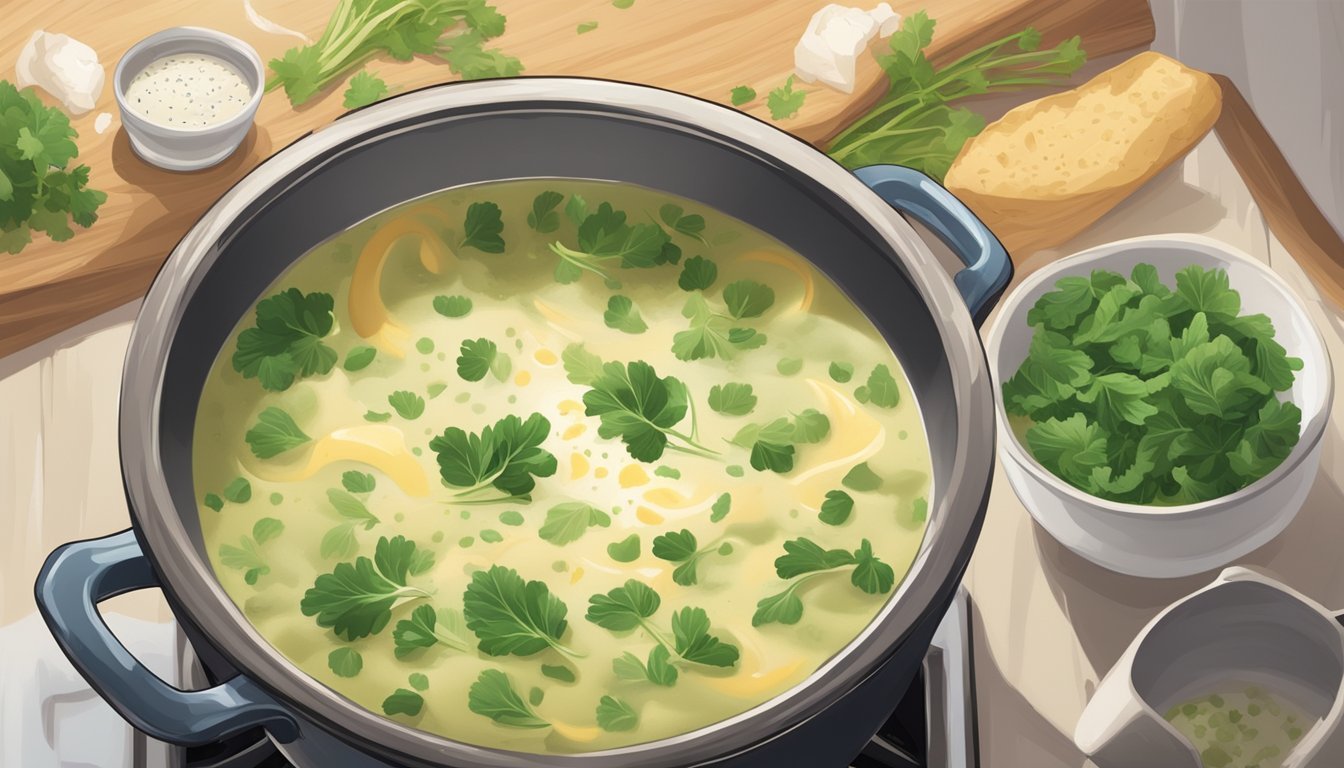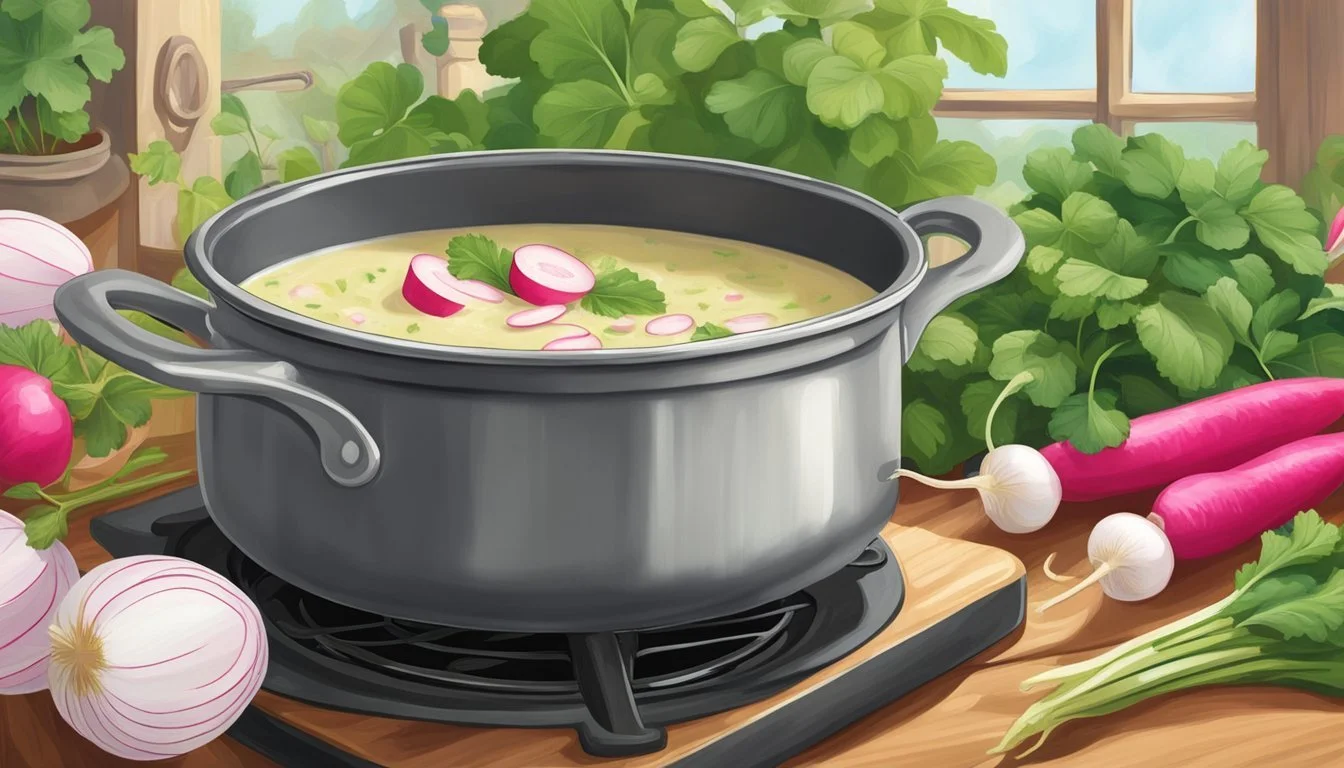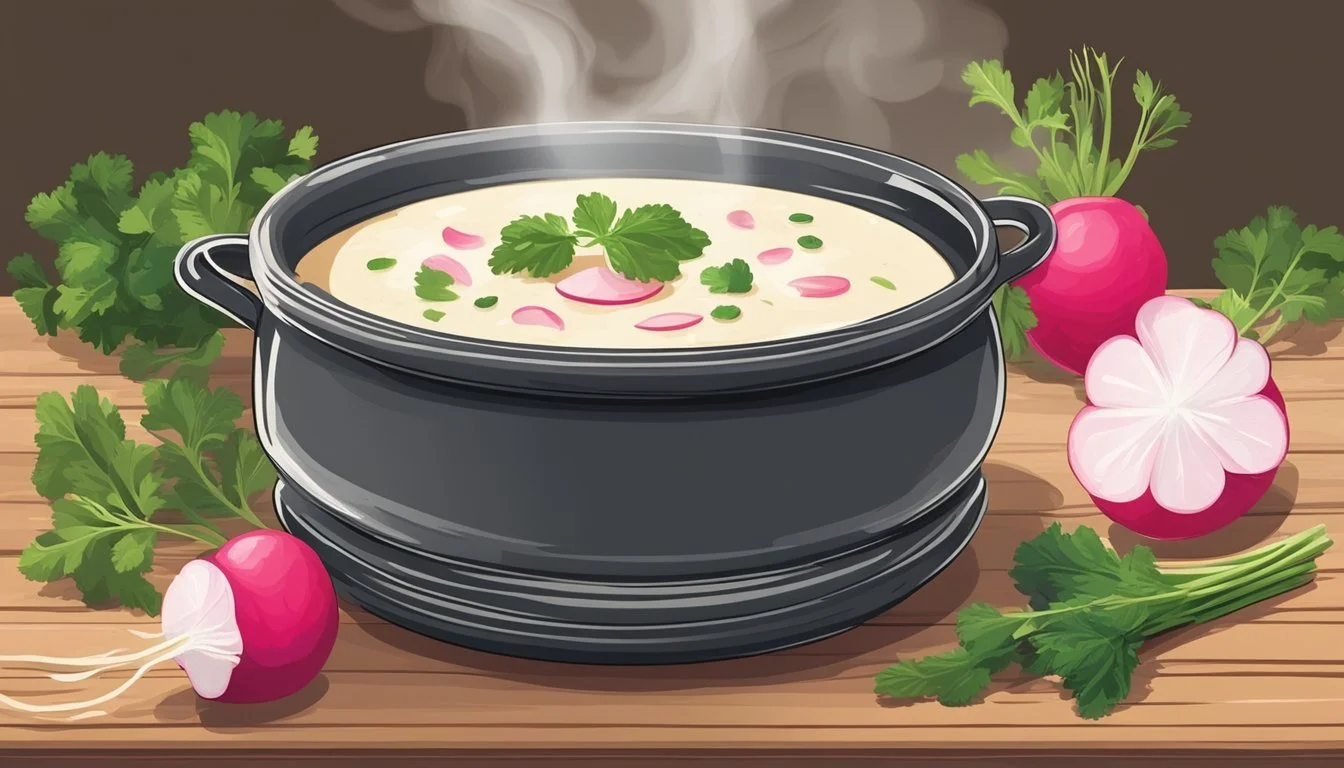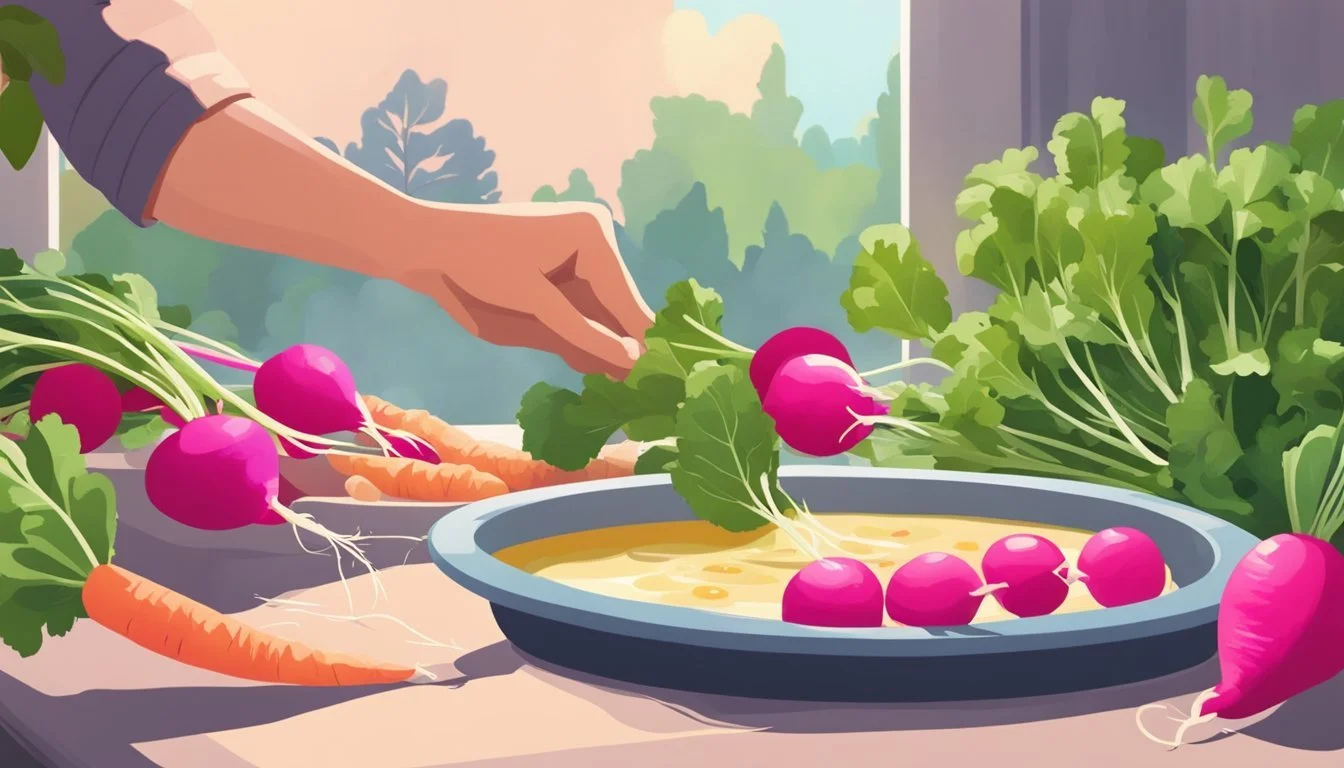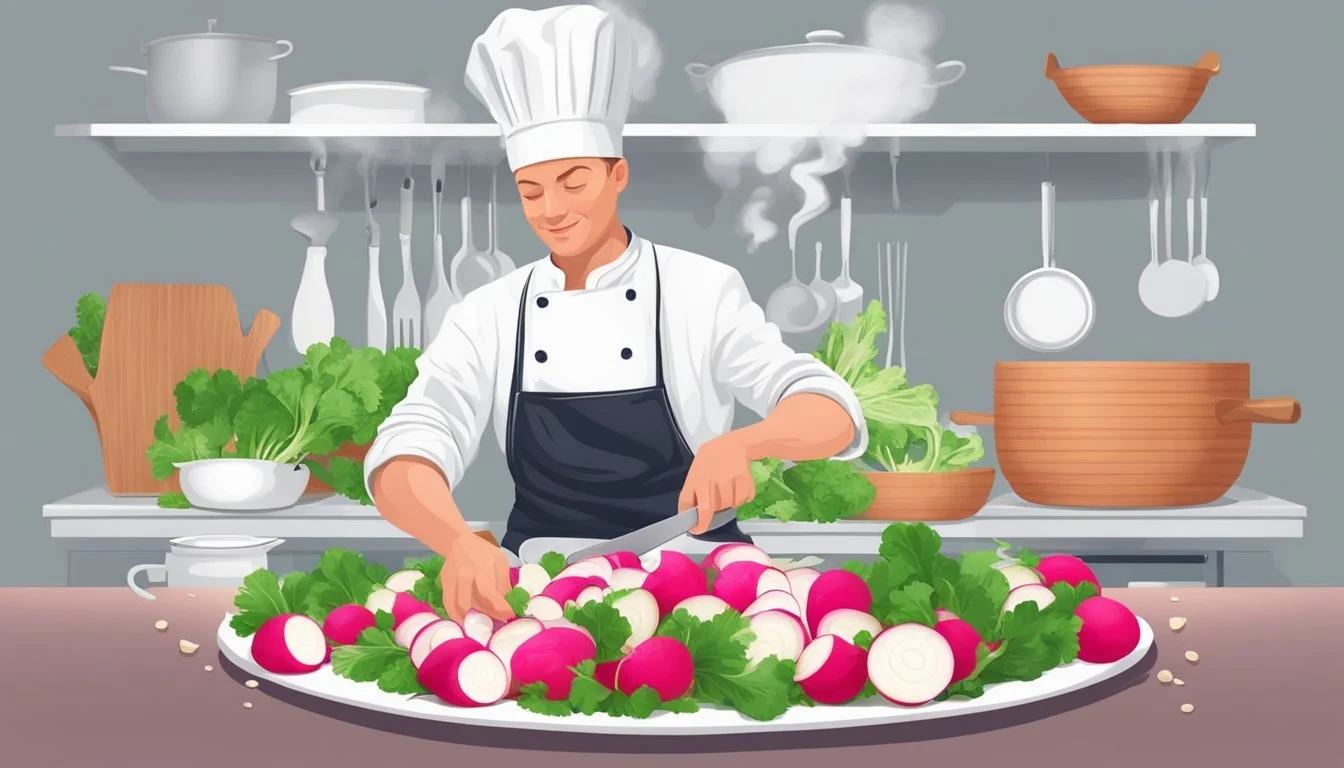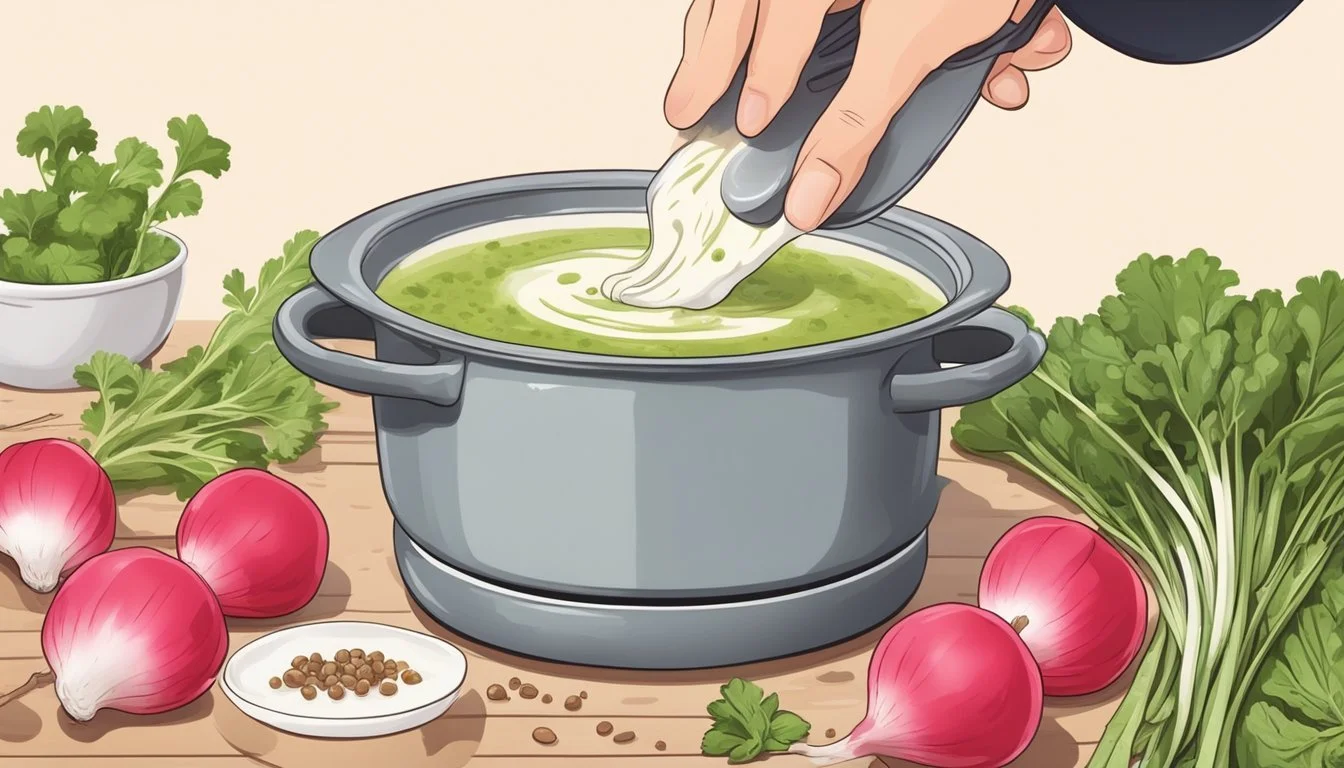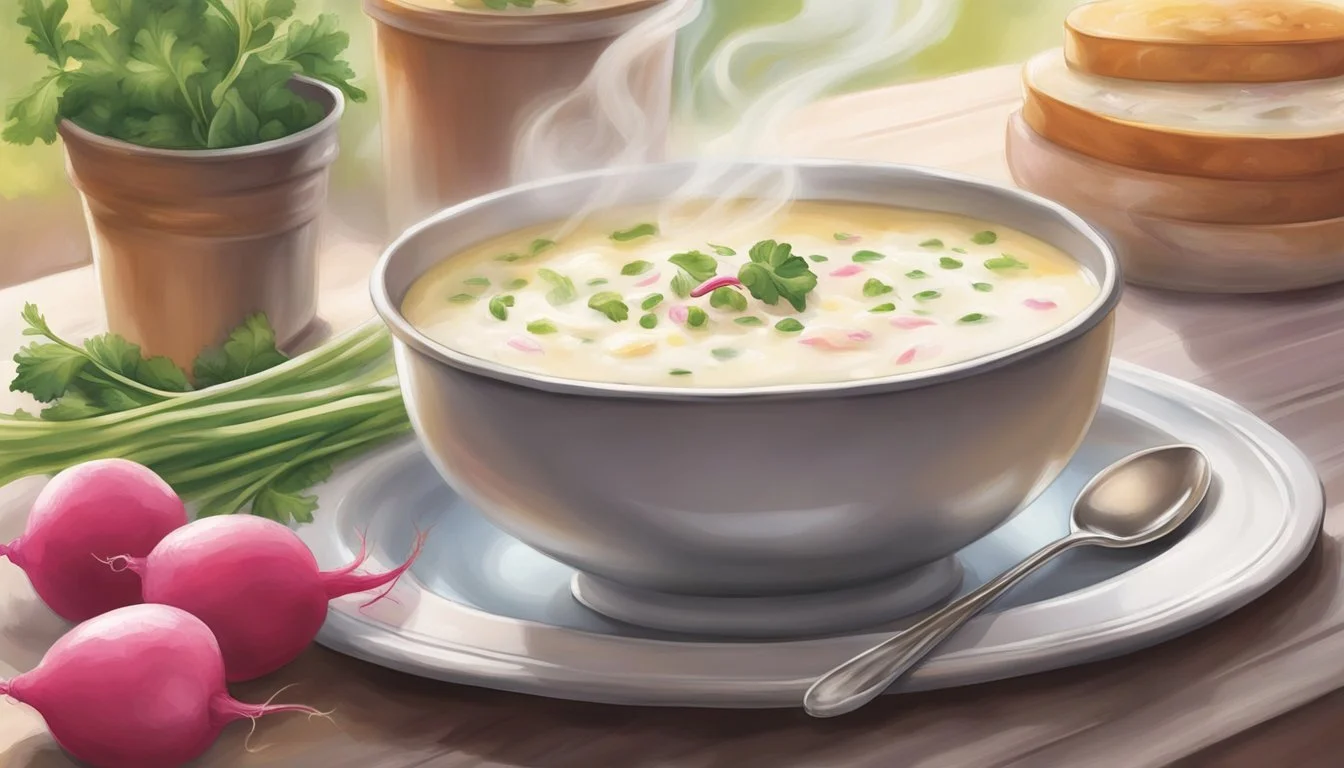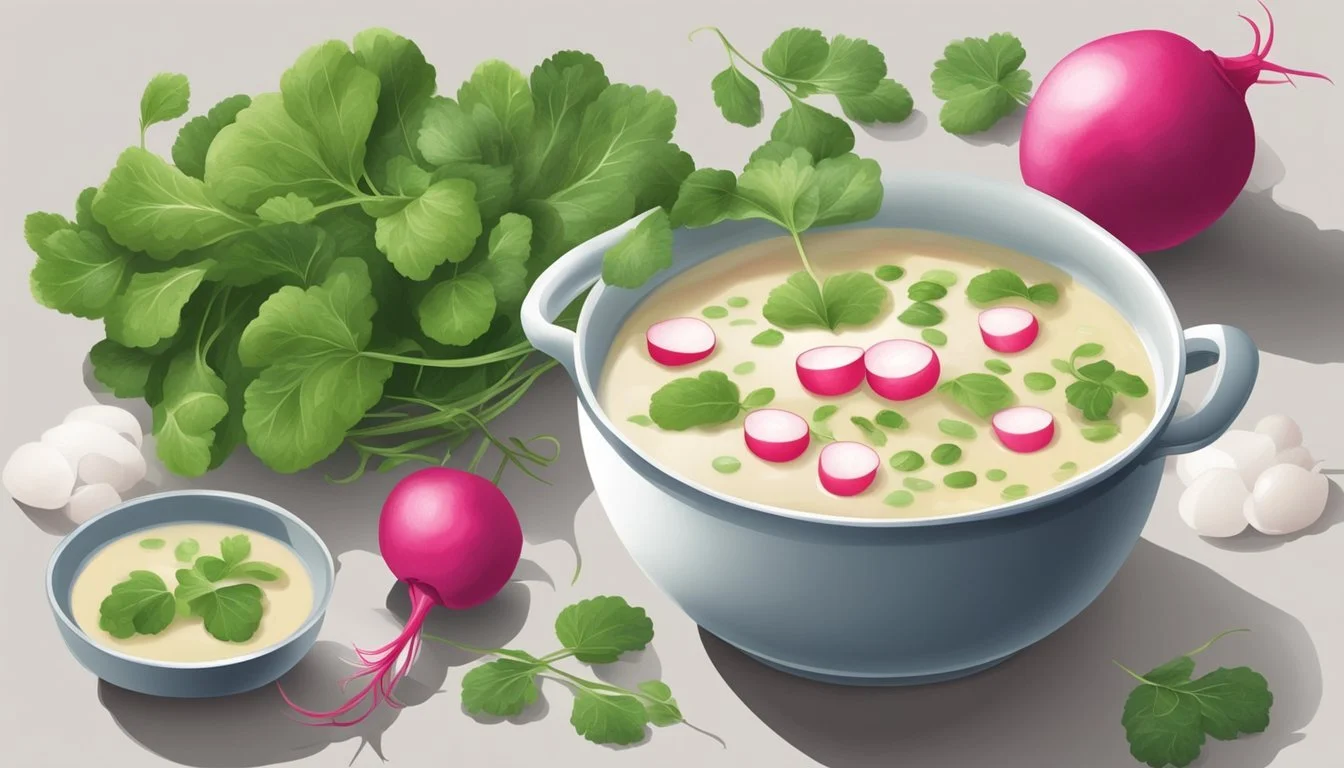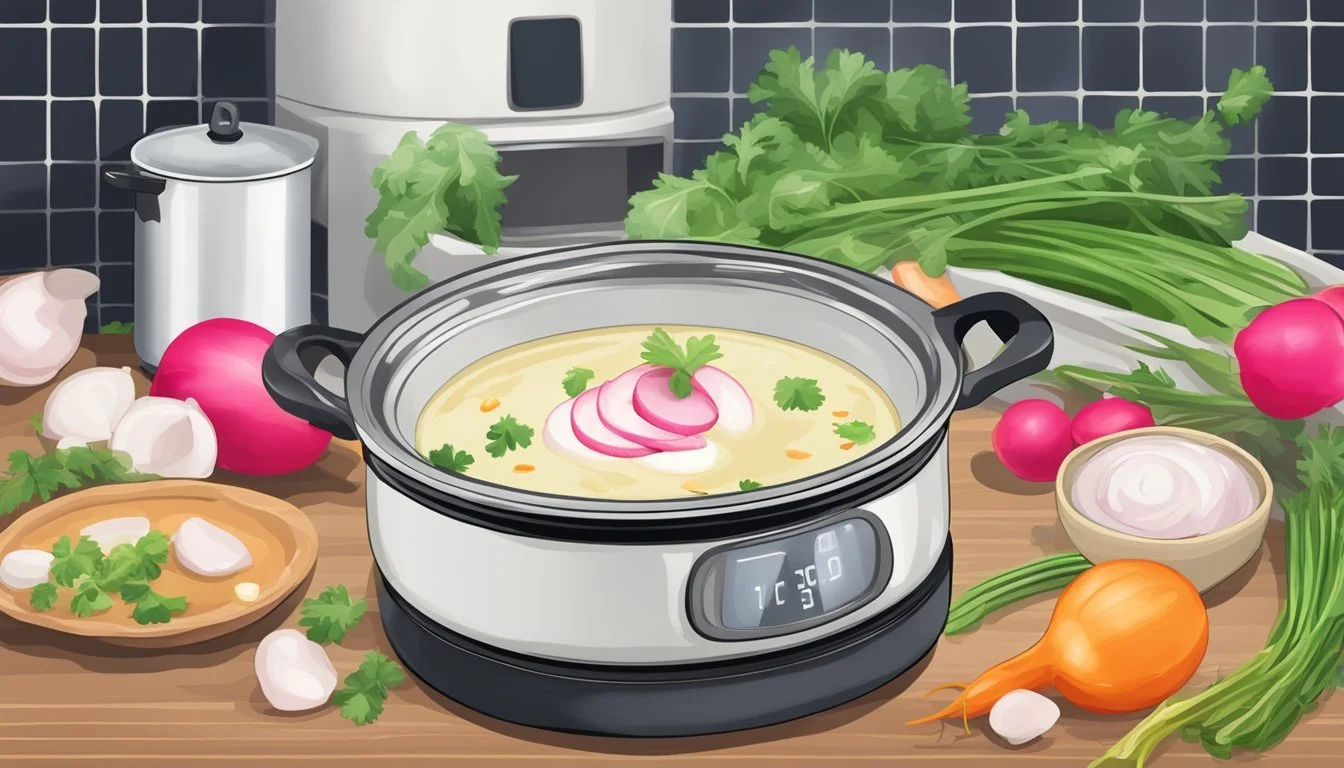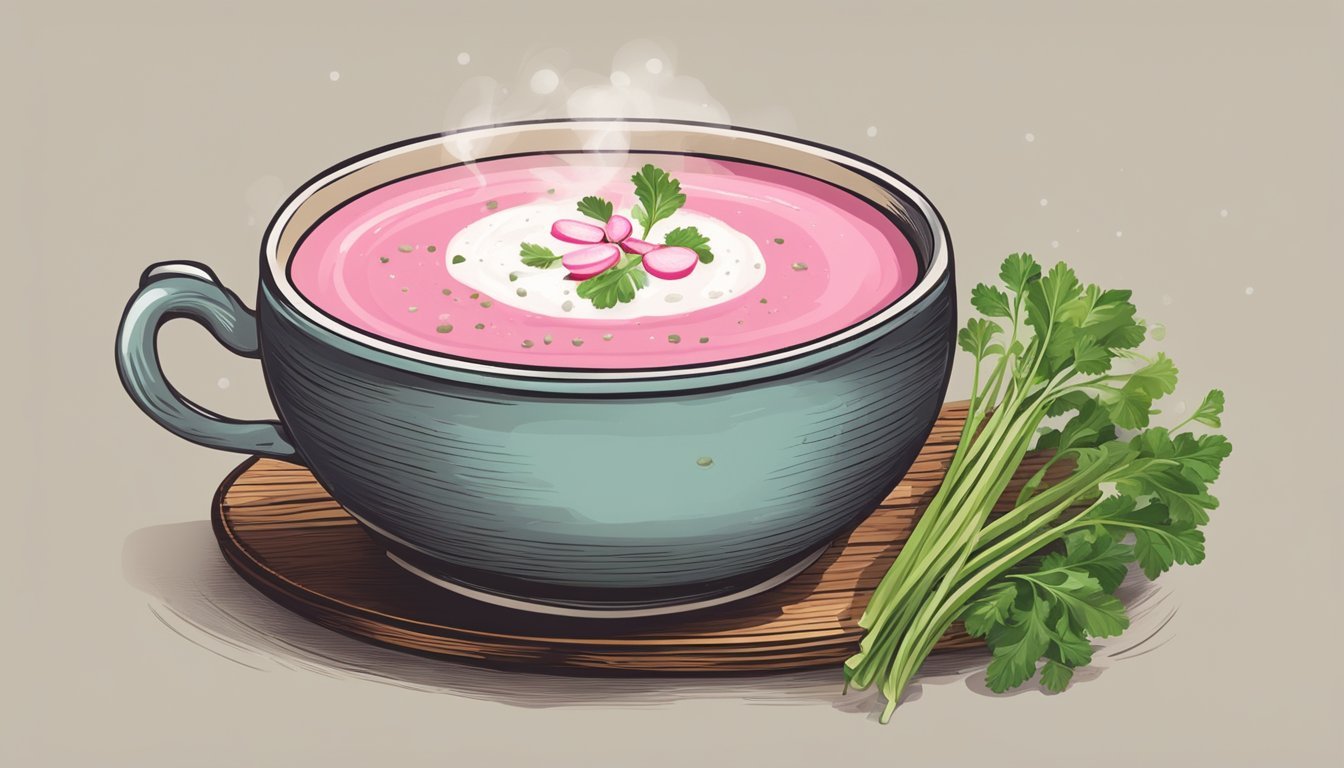Radish Top Soup
A Peppery, Creamy Starter Unveiled
Radish Top Soup emerges as an innovative solution to food waste while offering a peppery, creamy starter that delights the palate. Often discarded, radish greens contain valuable nutrients and possess a vibrant, peppery flavor that complements the creamy texture of a well-prepared soup. This dish serves as an excellent appetizer, introducing diners to a meal with its bold flavor profile and smooth consistency.
The preparation of Radish Top Soup typically involves sautéing a mirepoix of onions (What wine goes well with onions?) and other aromatic vegetables before the radish greens are added, allowing the soup base to develop a depth of flavor. The incorporation of potatoes or even a splash of cream elevates the soup's texture to a creamy and velvety consistency. It's a versatile dish that accommodates various additional ingredients and adjusts to dietary preferences, including vegan and vegetarian options.
Presented as a starter, this soup sets the stage for the courses to follow, offering both a nourishing and comforting beginning. Chefs and home cooks alike are turning to Radish Top Soup to utilize the whole vegetable, reducing waste and unlocking the full potential of their ingredients. The result is a sustainable, health-conscious, and intriguing first course that promises to leave diners both satisfied and curious about the innovative use of traditional ingredients.
History and Origin of Radish Top Soup
Radish top soup, a dish that integrates the peppery leaves of radishes, is steeped in a tradition of resourcefulness and maximizing the entire plant. Radishes have been cultivated for their root and leaf since ancient times, and their history is closely intertwined with the development of various cuisines around the world.
Traditions: In many cultures, radish greens are not discarded but used in a variety of dishes, reflecting a tradition of no-waste cooking. The practice embraces the entirety of the radish plant, a testament to a time when every part of the harvested produce was valued for its nutritional and culinary contribution.
Origins: The radish (Raphanus sativus) is believed to have been domesticated in pre-Roman times in Southeast Asia and eventually brought to the Mediterranean region, where radishes and their greens became staples. It is likely that radish top soup or variations of it have been part of European and Asian diets for centuries, though the exact origin remains hard to pinpoint due to the commonality of the ingredients.
Culinary Use:
Radishes: Typically grown for their roots, known for their crisp texture and peppery flavor.
Radish Greens: Slightly spicy and pungent leaves of the radish plant, often used in soups (What wine goes well with soups?) and salads.
The recipe for radish top soup evolved from simplicity and economy—using all parts of the radish to create a nourishing meal. While this starter may not have a single point of origin, its widespread presence in regional cooking highlights a shared understanding of making full use of available ingredients. The soup's creamy texture flavoured with radish greens speaks to a culinary history that is both rich and intimately connected to the land and its cycles.
Health Benefits
The inclusion of radishes in soup evokes a harmonious blend of flavor and health virtues. Radishes boast a robust nutritional profile, encapsulating several key nutrients beneficial to overall health.
Nutritional Value: Radishes are a low-calorie option, perfect for those conscious about their energy intake. Despite their small size, they make a substantial impact due to their rich array of vitamins and minerals.
Caloric Composition: Aiding in weight management, radishes provide few calories, making them ideal for a health-conscious diet without compromising taste or satisfaction.
Fiber Content:
Radishes are a good source of dietary fiber, which supports digestive health and helps maintain a feeling of fullness, contributing to weight control.
Vitamins and Minerals:
Vitamin C: Radishes are an excellent source of vitamin C, an antioxidant that strengthens the immune system and promotes healthy skin.
Vitamin A: Available in radish greens, vitamin A plays a vital role in vision and immune function.
Potassium: With a healthy dose of potassium, radishes contribute to cardiovascular health by helping to regulate blood pressure.
Calcium: Essential for strong bones and teeth, calcium can also be found in radishes.
Iron: Important for the production of hemoglobin, iron is another mineral present in radishes.
Sodium Content:
Recognized for their low sodium content, radishes are suitable for a heart-healthy diet, as they can help manage blood pressure and reduce the risk of cardiovascular disease.
Radish Top Soup emerges not only as a flavorful starter but also as a health-conscious choice packed with essential nutrients while being low in calories and sodium.
Selecting Quality Radishes
When one seeks the key ingredient for Radish Top Soup, quality radishes, especially red radishes, are essential. Their freshness dictates the flavor and texture of the soup.
Peak Seasonality: Radishes are best in spring and early summer, but they can be found year-round. Opt for seasonal produce to ensure peak flavor and nutrition.
Visual Inspection: Look for radishes with bright, vibrant red skins. They should feel firm to the touch, with no soft spots or blemishes. Dull or dry-looking radishes may be past their prime.
Freshness of Radish Tops: The condition of radish greens is a telltale sign of freshness. They should appear bright green and perky, not wilted or yellowed. If the tops are removed, inspect the radish bulbs for signs of freshness.
Storing to Retain Freshness: To preserve their quality, store radishes in the refrigerator. Place them in a perforated bag to allow air circulation. It's best to separate the tops from the bulbs to prevent the greens from drawing out moisture.
Quality Checklist
Color: Bright, deep red skins
Texture: Firm bulbs, crisp tops
Top Condition: Bright green, not wilted
Storage: Refrigerate in a perforated bag
By selecting radishes adhering to these guidelines, chefs ensure that the foundation of their Radish Top Soup is as fresh and peppery as it is meant to be.
Essential Ingredients
For a classic Radish Top Soup, the key elements are both the roots and the greens of radishes. Using radish greens not only reduces waste but also provides a peppery taste, similar to arugula or mustard greens. Radishes themselves, when cooked, lend a mild, earthy flavor that balances the greens.
Butter is often used to sauté onions, forming the soup's aromatic base. Onions are a must for adding sweetness and depth of flavor.
Potatoes help thicken the soup, giving it a creamy texture without the need for heavy cream. This starch-rich vegetable breaks down during cooking, enhancing the soup's body.
Garlic adds another layer of flavor. Even a single clove can make a significant difference, contributing a slight kick and aroma.
A savory broth acts as the liquid foundation. Vegetable or chicken broth are common choices that infuse the soup with additional flavor.
Incorporating milk introduces creaminess. For a dairy-free option, one could blend cashews with water to achieve a similar rich texture.
Seasonings are essential; salt and pepper are basics that enhance the natural flavors of the ingredients. One may also add parsley for a fresh, herby note.
Ingredient Role in the Soup Radish Greens Provide a peppery flavor and vibrant color Radishes Add a mild, earthy flavor and texture Butter Used for sautéing and flavor enhancement Onion Sweetness and depth of flavor Potato Thickness and creaminess Garlic Aromatic kick Broth Foundation of the soup, adds flavor Milk Creaminess (can be substituted with cashew cream) Salt Enhances natural flavors Pepper Adds spice and seasonings Parsley Fresh, herby note (optional)
This blend of essentials promises a soup that's both flavorful and comforting, suitable as a starter or a light meal on its own.
Equipment Needed
Preparing radish top soup requires certain kitchen tools to ensure a smooth cooking process. This section outlines the necessary equipment to create a perfect creamy and peppery radish top soup.
Cutting Tools:
A sharp chef's knife is essential for finely chopping onions, radishes, and other vegetables.
A cutting board offers a stable surface to prep your ingredients.
Cooking Utensils:
A large saucepan or soup pot is the primary cooking vessel for sautéeing and simmering the soup.
A wooden spoon or heat-resistant spatula is ideal for stirring ingredients to prevent sticking and burning.
Blending Equipment:
An immersion blender offers the convenience of blending the soup directly in the pot, minimizing the cleanup.
Alternatively, a stand blender or a food processor can be used. If using a stand blender, ensure to blend the soup in batches and take precautions when blending hot liquids.
Additional Tools:
Measuring cups and spoons are important for adding precise amounts of broth, milk, and spices.
A ladle assists with serving the soup while maintaining a clean presentation.
Each piece of equipment plays a specific role in the creation of radish top soup. Remember to use these tools with care and follow safety guidelines, especially when handling hot soup and sharp utensils.
Preparing the Radishes
Before diving into the cooking process, it is crucial to properly prepare the radishes. This involves a thorough cleaning to remove any dirt and trimming to discard the rough parts. Once the radishes are prepped, sautéing unlocks their natural flavors, enhancing the overall taste of the soup.
Washing and Trimming
To begin, one should ensure the radishes are free from any soil or debris. Because radishes are root vegetables, they often harbor residual dirt from the ground.
Place the radishes under cold running water.
Gently scrub their surface with a clean brush to remove dirt.
Pat the radishes dry with a towel.
After washing, it's time to trim the radishes. Using a sharp knife, remove the stem and root ends. Also, discard any blemished leaves.
Sauteing Radish Tops
Sauteing radish tops is an important step that shouldn't be overlooked. It softens their texture and mellows the peppery bite, making them ideal for a creamy soup.
Heat a pan over medium heat and add 2 tablespoons of olive oil or unsalted butter.
Once hot, add the radish tops to the pan.
It's important to stir the radish tops frequently to ensure even cooking. They should be sautéed until wilted, which typically takes about 3 to 5 minutes. Sauteing not only prepares them for the soup but also releases their aromatic flavors, which are key to the dish.
Soup Base Preparation
Creating a strong foundation for Radish Top Soup begins with cooking aromatic vegetables to develop deep flavors. The process then moves on to integrating starchy potatoes and a blend of liquids, which contribute to the soup's creamy texture.
Cooking Aromatics
The cook starts by sautéing onions in a pan until they're translucent, which typically takes about 3 to 5 minutes. This is a crucial step as onions lay the flavor groundwork. For additional depth, garlic can be added and sautéed until fragrant, careful not to let it brown too much, as this could introduce bitter flavors.
Adding Potatoes and Liquids
Once the aromatics are softened, cubed potatoes are stirred in. They act as a thickener for the soup, providing body and a velvety texture upon cooking. The mixture is then covered with broth and water. The cook brings the combination to a boil, then reduces it to a simmer on low heat. This gentle cooking method allows the flavors to meld and the potatoes to cook thoroughly without falling apart.
Blending and Seasoning
The transformation of solid ingredients into a velvety soup is achieved through careful blending, while the right seasoning accentuates the natural flavors of the radish greens.
Pureeing Soup
After cooking the radish tops with the other ingredients until they’re soft, chefs transfer the mixture to a blender or food processor to achieve a smooth puree. For those who prefer not to transfer hot liquids, an immersion blender offers convenience by pureeing the soup directly in the pot. The goal is a homogeneous texture without any solid pieces, which is a mark of a properly executed radish top soup.
Equipment options for pureeing:
Standard blender (ensure slight cooling before blending)
Food processor (work in batches if necessary)
Immersion blender (blend right in the cooking pot)
Final Seasoning
A balanced final seasoning is essential to bring out the soup's character. Chefs adjust the seasoning with salt and freshly ground pepper, tasting and tweaking until the flavor profile is just right. The peppery notes of the radish greens pair well with these classic seasonings, enhancing the soup’s complexity.
Recommended seasonings:
Salt (to taste)
Freshly ground pepper (to taste)
Enhancing Creaminess
Radish top soup's velvety texture can be attributed to the judicious use of dairy products and plant-based alternatives. These additions are crucial for imparting a luscious mouthfeel and a rich flavor profile.
Key Ingredients for Creaminess:
Dairy Products Plant-Based Alternatives Butter Nut-based milks Sour Cream Coconut milk Crème Fraîche Soy milk Yogurt Almond milk Milk Oat milk
Incorporating butter as the base of the soup not only enhances the flavor but also contributes to the overall creaminess due to its high saturated fat content. When using butter, one should melt it gently to avoid burning, then slowly cook the aromatics until they're tender, thus laying the foundation for a smooth consistency.
To finish the soup, stirring in milk adds a subtle richness without overpowering the fresh taste of the radish tops. For those seeking an even creamier consistency, options such as sour cream, crème fraîche, and yogurt serve as excellent stir-ins. Each component brings a unique tang and texture to the final dish. It's essential to add these elements at the end of the cooking process and to heat them gently to prevent curdling, preserving their creamy integrity.
For a lighter variant that still maintains creaminess, one might opt for unsweetened plant-based milks. These alternatives are lower in saturated fats while still providing a creamy consistency and a complementary nutty or sweet undertone, depending on the plant milk selected.
Serving Suggestions
When presenting Radish Top Soup, the right garnishes and accompaniments can transform this creamy soup into an elegant starter. Choosing the appropriate additions also ensures that each serving is both visually appealing and bursting with complementary flavors.
Garnishes
To elevate the taste and presentation of the soup, one might consider adding:
Thinly sliced radish: Provides a crisp texture and a peppery bite.
Fresh parsley: Offers a subtle herby freshness with each spoonful.
Finely chopped cucumber: Adds a refreshing crunch to the creamy soup.
Grated ginger: A small sprinkle can lend a mild, spicy warmth.
Accompaniments
Pairing the soup with the right side can enhance the dining experience:
Crusty bread or rolls: Ideal for dipping and savoring the creamy texture.
Croutons: They add a pleasant crunch and can absorb the soup's flavors.
Salad with a light vinaigrette: A simple salad balances the creaminess of the soup with acidity.
Dietary Variations
Radish Top Soup can be transformed to accommodate a range of dietary needs without compromising on taste or nutritional value. With simple ingredient swaps, one can create a version that's vegetarian, vegan, or gluten-free.
Vegetarian and Vegan Options
For those following a vegetarian diet, the base of the soup can be made with a choice of either vegetable broth or chicken broth, though the latter obviously does not apply for a vegan diet. Vegetable broth is the ideal substitute to maintain the flavor profile while keeping it meat-free.
To adapt Radish Top Soup for a vegan diet, dairy products should be replaced with plant-based alternatives. Instead of butter, use olive oil or vegan margarine for sautéing. Where the recipe calls for cream to achieve a creamy texture, opt for cashew cream or coconut milk. These replacements yield a similar richness to their dairy counterparts.
Gluten-Free Adaptations
When creating a gluten-free version of Radish Top Soup, chefs must ensure all added ingredients do not contain gluten. Most Radish Top Soup recipes are naturally gluten-free, as the primary ingredients are radish tops, onions, potatoes, and broth. However, one should always double-check the labels on store-bought broth or any additional seasoning blends, as they could potentially contain gluten. A homemade broth is a safe bet for those with severe gluten sensitivities.
Both dietary variations rely on the core principle of substituting certain ingredients to cater to specific needs without diluting the soup's distinct peppery flavor and creamy texture.
Storing and Reheating
When carefully stored, Radish Top Soup maintains its quality and flavor. The two primary methods for storage are refrigeration and freezing, which can significantly extend the life of the soup.
Refrigeration
Radish Top Soup should be refrigerated within two hours of cooking to preserve its freshness. It can be kept in the refrigerator for up to three days. To refrigerate, one should:
Transfer the soup into an airtight container.
Let it cool to room temperature before sealing and placing it in the fridge.
To reheat refrigerated soup, they should:
Pour the desired amount into a saucepan.
Warm it on a medium heat, stirring occasionally until heated through.
Freezing
For longer storage, freezing is an effective method. To freeze Radish Top Soup, they should:
Allow the soup to cool completely after cooking.
Portion it into freezer-safe bags or containers, leaving some space for expansion.
Label with the date and freeze for up to 2-3 months.
When ready to consume, they can:
Thaw it overnight in the refrigerator.
Alternatively, reheat directly from frozen by placing the soup in a saucepan over low heat, gradually increasing the temperature until it's completely warmed through.
Nutritional Information
Radish Top Soup is a wholesome dish that can deliver several nutritional benefits when prepared with health in mind. The peppery greens of radishes contribute both flavor and a range of vitamins and minerals, while the creaminess typically comes from ingredients adding both protein and fat.
Calories: An average serving of Radish Top Soup contains approximately 100-200 calories, depending on the addition of ingredients like potatoes, cream, or milk.
Protein: This soup can offer a moderate amount of protein, especially if made with chicken broth or blended with milk. The protein content may range from 3 to 5 grams per serving.
Fat: The fat content largely depends on the use of butter or oil in the recipe, with variations using low-fat milk or cream reducing total fat. Expect about 5-10 grams per serving, with a portion coming from healthier unsaturated fats.
Nutrient Amount per serving Carbohydrates 15-30 grams Fiber 2-4 grams Sugar 3-5 grams Cholesterol Varies Sodium 300-600 mg
The soup’s carbohydrate profile is balanced between simple sugars and complex carbohydrates, reflecting the addition of vegetables like onions and potatoes. Dietary fiber content is generally good due to the radish greens and other vegetables.
Cholesterol levels could vary if dairy is added but will remain low if plant-based alternatives are used. Sodium content should be monitored by adjusting the salt added during cooking and the choice of broth; low-sodium options are ideal for those managing intake.
In terms of micronutrients, radish greens are high in vitamin C, vitamin K, and potassium. The vegetables in the recipe enhance the fiber and micronutrient content, making Radish Top Soup a nutritiously dense starter for a meal.
FAQs
In this section, readers will find answers to common queries about Radish Top Soup and guidance on how to enhance their cooking experience. It provides practical advice on serving, recipe variations, and ingredient substitutions.
Common Questions
Q: Can Radish Top Soup be served cold?
A: While traditionally served warm, Radish Top Soup can also be enjoyed as a chilled dish, making it versatile for different seasons.
Q: Are there vegetarian options for the broth?
A: Yes, vegetable broth is an excellent substitute for chicken broth, maintaining the soup's flavor profile while making it suitable for vegetarians.
Tips and Tricks
Serving Tips:
To elevate the presentation, garnish the soup with a dollop of sour cream, a sprinkle of fresh herbs, or a few thinly sliced radishes.Recipe Variations:
For a different twist, one could add other greens like spinach or arugula, or use sweet potatoes instead of regular potatoes for an interesting flavor.Ingredient Substitutions:
Dairy-free milk such as almond or coconut milk can replace cow's milk for those with dietary restrictions.
If radish tops are unavailable, beet greens are a good alternative. They offer a similar peppery taste.

